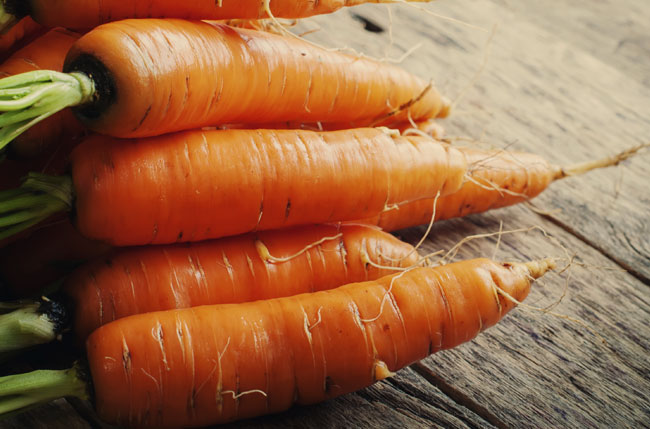
Native to Europe and Southwestern Asia, carrots are root vegetables that people have cultivated for millennia. The carrot plant originally had white, woody roots and it was grown for its aromatic leaves. The leaves of the carrot plant were originally grown as a medicinal herb by the ancient Romans and Greeks who believed carrot leaves were an aphrodisiac, and that they could prevent poisoning. The aromatic leaves of carrot plants were later used as culinary herbs. The carrot plant is related to other herbs like parsley, fennel, dill and cumin. The root of the plant—the carrot itself—was considered a type of parsnip due to their similar colors and flavors. The earliest carrots were white and fibrous, almost woody. The carrot was virtually lost in Europe during the medieval period when the vegetable fell out of favor. Asian varieties of carrots were reintroduced to Europe by Arab Muslims. Orange colored carrots were likely a mutation in Asian carrots that appeared in about sixth century, and they were mostly cultivated in the Netherlands. By the seventeenth century, carrots were softer and sweeter, with no woody core thanks to generations of selective breeding. Today, the familiar orange carrot is available year-round.
The simple carrot is used in a surprisingly wide variety of applications from simple to sophisticated. Raw carrots, served with dips like hummus or ranch dressing, are a healthy snack or appetizer. Shredded carrots are great on salads. Carrot juice makes it easy to get all the nutrients that carrots offer. As a side-dish, carrots are often baked, boiled, roasted or steamed. Herbs like rosemary, sage, cumin and thyme pair well with carrots and they add great depth of flavor. Overcooking carrots is known to strip carrots of their nutrients. To ensure that carrots stay tasty and nutritious, cook them lightly so they retain their crispiness. Cooking carrots to the point where they become mushy is when they will begin to lose their nutritional value. To boil carrots, put thickly cut carrots in a pot and fill with just enough water to cover the carrots. Bring the water to a boil, lower the heat and let simmer for about five minutes. For delicious roasted carrots, place thick slices of carrot in a wide, deep roasting pan. Drizzle olive oil or melted butter on the carrots and season with a generous sprinkling of sage and rosemary. Roast carrots for about twenty minutes at 400 degrees. Check the carrots frequently because they may take more or less time depending on their thickness. Medallions of carrot are great additions to a hearty winter soup, or roasted along with other vegetables and meats. Carrot cake is a wonderful use for the sweet vegetable. Try something different by making cupcake-size carrot cake with pineapple added to the traditional cream cheese frosting. Adding pumpkin to carrot cake brings a whole new, unexpected layer of flavor.
To select a good carrot, pick one with a deep, uniform orange color (some heirloom varieties of carrot come in other colors, especially purple.) Lumpy carrots are often just as tasty as more shapely carrots, but they are difficult to clean and peel. Avoid carrots that are limp or have wilting greens attached to their tops. Medium sized carrots are usually the best option because larger carrots can be tough and don’t taste as sweet as smaller ones. It is advisable to select carrots that still have greens attached to their tops because it means the carrot is fresher. Carrots can be kept in the refrigerator for about two weeks. Remove any greens from the carrot tops before storing the carrot because the leaves can cause the vegetable to lose moisture. Always wash fresh carrots before preparing.


 BACK TO PRODUCTS
BACK TO PRODUCTS